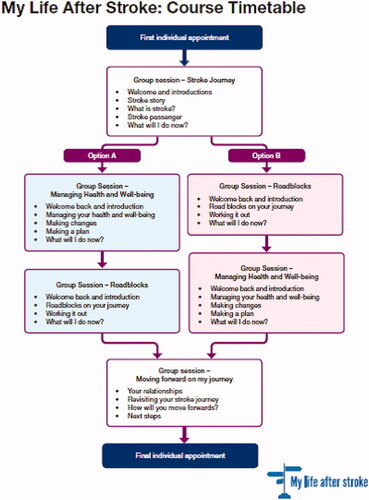Figures & data
Figure 1. Structure and content of the MLAS programme. A flow chart showing the ordering of MLAS sessions. MLAS starts with a first individual appointment, followed by the Stroke Journey group session then will undertake either option A (Managing Health and Wellbeing followed by Roadblocks sessions) or option B (Roadblocks then Managing Health and Wellbeing). Whether option A or B is taken, the final group session is Moving Forward on my Journey followed by the final individual appointment.

Table 1. outline of the 3-day facilitator training course.
Table 2. Demographics of stroke survivors and carers that attended MLAS.
Figure 2. Recruitment flow chart. A flow chart showing 168 people were invited to take part in the MLAS feasibility study, leading to 90 who replied, 36 of these were interested in the study. 17 consented and 15 completed the study. Reasons for not being interested or consenting or withdrawing are shown and included people having other commitments or being unable to attend session dates, mobility or transport problems to get to appointments, feeling too well or fully recovered from their stroke, their stroke being too long ago and some people did not provide a reason.

Table 3. Attendance rates and reasons for non-attendance for each MLAS session.
Table 4. Baseline and change in stroke survivor questionnaires scores.
Table 5. Summary of participant feedback in the feasibility study.
